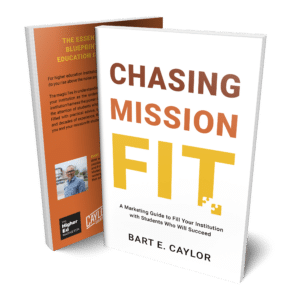Audience-Centric Marketing: Marketing in Service of Your Audience
Audience-centric marketing is a paradigm shift that can transform mediocre content into high performance marketing. Learn more!
Marketing Strategies
When it comes to strategic communication, where do you begin?
It’s all too easy in higher ed marketing to get caught up in chasing the next shiny object.
Sometimes, bouncing from tactic to tactic without taking a step back – or even reverting back to last year’s plan – may seem like the only option.
But putting your communication strategy on autopilot is not a good idea. Why?
Because what worked in the past doesn’t seem to resonate with the current generation.
So where do you go to get the right inspiration for your strategic communication plan?
 According to Eric Henry, the President of Carousel Digital Signage, the place to begin is with your school’s “why.”
According to Eric Henry, the President of Carousel Digital Signage, the place to begin is with your school’s “why.”
When you dig deep into your school’s mission, you’ll begin to find the guidance you need for crafting communications that resonate deeply with your target audiences.
In this episode of The Higher Ed Marketer, Eric offers us a fresh perspective on how schools can adapt to the challenges of today through strategic communications.
As Henry explains, one of the common pitfalls in higher education is the tendency to chase new tactics without aligning them with a broader strategy.
Schools often jump from one communication tool to another, trying Instagram one day and switching to TikTok the next.
This is just chasing one shiny object until the next one pops up.
Few higher ed administrators and marketers step back to ask the most fundamental question: What are we really trying to accomplish?
Instead, most higher ed institutions are stuck trying to, as Eric puts it, cater even more to students rather than engaging them with a compelling mission.
In higher ed, the thing I keep hearing in the conversation is, “We’re doing all of these things for these students, yet they’re still not engaged! So, how can we cater more to our students?”
I have two college age kids myself, and what I’ve noticed is, if I want to engage my kids, they need to have a purpose and a mission.
[The question should not be] do I cater to my kids more? [Rather, it should be how] do I get them on mission?
This doesn’t mean that you need to ignore the desires and goals of your prospective students.
But it does mean that addressing what prospective students want is not the best place to begin your strategic communication plan.
To help improve both enrollment success and overall student outcomes, schools need to define a higher purpose for both the institution and the students.
When students feel that their presence on campus matters and that they are contributing to a larger purpose, engagement naturally follows.
This mindset shift is essential in today’s educational environment, where many students are struggling to stay connected and engaged.
“We’re seeing 4.0 students from high school come into college and completely disappear,” Henry notes, highlighting the fact that the solution goes way beyond a simple change of tactics.
Henry’s approach to strategic communications goes beyond mere tools at the tactical level. He encourages institutions to think like marketers, asking critical questions such as:
By answering these questions and creating a mission-driven communications strategy, schools can shift their focus from simply providing information to engaging students in a meaningful way.
Engaged students are ones that see their purpose. [They understand that their] showing up actually matters and that their getting a really good education actually matters in what is happening in our society.
[They need to see how] they can make a difference when they start buying into that now.
Eric stresses the fact that once institutions have answered the “why” question (which is essentially the mission with which they’re going to engage students), it’s then time to think through the “how” questions of communications.
How do we make sure that students are made aware of the different opportunities and events that are happening so they can get involved?
While Henry’s company, Carousel Digital Signage, specializes in digital tools, his overarching message is that technology should support human interaction.
There are all kinds of tools that we can use to get students engaged in actually showing up to these different functions.
We’re a technology company that is trying to increase face-to-face interaction. I’m writing software so that people will actually put their phones down.
Strategic communication helps students put away their screens and engage with the campus and their peers face-to-face.
By utilizing digital signage in residence halls, academic buildings, and student unions, schools can deliver timely, relevant content tailored to specific groups of students.
For instance, a student walking through the history department might see digital signage promoting an upcoming event relevant to their major.
That same message could appear on their phone through a campus app, ensuring multiple touchpoints and reducing the likelihood that important information gets missed.
Eric also emphasizes the importance of making engagement easy.
“If a student can’t register for an event or a class instantly, it won’t happen,” he says.
Schools must minimize friction in their processes, allowing students to act immediately when they receive important information.
Real-time communication is a game changer when it comes to keeping students engaged and informed on campus, and one of the best tools we have for this is digital signage.
Providing students with the ability to pre-schedule and strategically delivering content through digital signage – whether in residence halls, classrooms, or high-traffic areas – are powerful ways to make sure your messaging hits the right audience at the right time.
It’s not just about putting up a message and hoping someone sees it.
It’s about reinforcing that message across multiple platforms—on their phones, on dedicated screens, and even on your website.
On a college campus, if I have dedicated signage screens in a residence hall and in hallways delivering content in all the places that matter, [the communication will be] more highly relevant.
So let’s take the event schedule for the sports complex. What is the most highly relevant content for that group of people? How can we deliver that content in the most timely fashion possible and repeat it as many times as possible and on dedicated screens?
But then also how can we reinforce [this content] on our website and on our personal devices?
Now we have a tool that allows you to publish directly to all your students’ phones [which enables you to] reinforce that same message because [their phone is what] they look at the most.
We can deliver real-time content in specific locations, reinforcing the university’s message and driving action without overwhelming students with irrelevant information.
The ability to track engagement, refine messaging, and keep content highly relevant is key.
Whether it’s encouraging students to attend an event or reminding them to register for classes, real-time, multi-channel communication through digital signage ensures your message isn’t just seen—it’s acted upon.
As much as Eric loves technology, he is clear about one thing: the tools are only as good as the strategy behind them.
Schools must resist the temptation to adopt new tools simply because other institutions are doing so.
Instead, they should focus on creating a strategic framework that aligns with their core mission and supports student success.
The key takeaway from this conversation? Start with strategy.
“It’s easy to get caught up in the latest technology or shiny object,” says Henry, “but without a clear purpose and plan, those tools won’t deliver the results you’re looking for.”
Listen to our full interview with Eric Henry to get even more insights into:
The essential marketing book every higher education institution needs! If you are a higher education marketing professional seeking a fail-safe plan to make your institution stand out, “Chasing Mission Fit” is your guide.
 Discover how to:
Discover how to:
So you can empower your institution with audience-focused marketing strategies, and attract mission-fit students who will flourish in your unique academic environment.
Ready to transform your institution’s marketing approach?
Order now!
Featured image by Xavier Lorenzo via Adobe Stock
Subscribe to The Higher Ed Marketer podcast today!